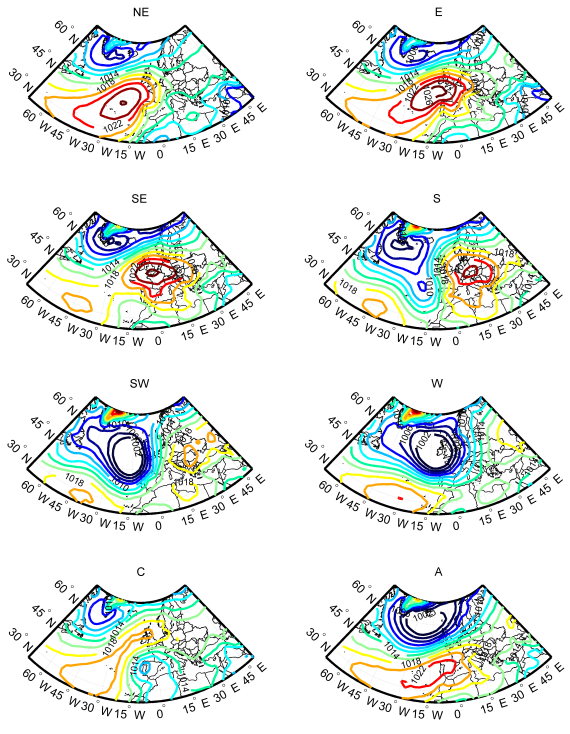Research
- Climate Variability
- Weather types
- North Atlantic Oscilation
- Blocking events
- Storm-tracks
- Cut-off low systems
- Climate extremes
- Vegetation dynamics
- Atmopsheric Rivers
- Nonlinear Analysis
- Natural Hazards
- Datasets
Weather types
Classifications have had a long history in meteorology and climatology. Until a few decades ago, classifications (generally called “catalogs of synoptic types”) were used mainly in weather forecasting (e.g. Hess and Brezowsky, 1952; Lamb, 1972).
In the Climatology and Climate Change group of Instituto Dom Luíz, the Lamb circulation weather types have been used widely. This classification of atmospheric circulation into weather types was carried out for the British Isles by Lamb, 1972. This was a manual classification, and was based on the analysis of daily SLP fields for the British Isles. The manual Lamb classification was adapted by Jenkinson and Collinson (1977) for an objective automated classification for the British Isles, which was later evaluated by Jones et al., 1993. This automated classification is based on the use of a set of indices associated with the direction and vorticity of geostrophic flow which are computed over Sea Level Pressure values obtain over regular grid datasets (e.g NCEP/NCAR Reanalysis, ERA40 Reanalysis, EMULATE reconstruction dataset, 20th Century Reanalysis or Global/Regional Climate models).
This automated method was later on adapted for different areas in the Iberian Peninsula; for the SE Iberian Peninsula (Goodess and Palutikof, 1998), for Portugal (Trigo and DaCamara, 2000). Full details of the method please refer to Trigo and DaCamara, 2000. In the following figure is shown the composites for Sea Level Pressure for the 10 pure circulation weather types, for the period 1961-2000, centred in the Iberia Peninsula using the NCEP/NCAR reanalysis.
In recent years, the usefulness of CWT classifications has been investigated for a wide range of applications, in scientific domains from climate to environmental areas.
In the Climatology and Climate Change group, the Lamb circulation weather types have been used in different applications:
- precipitation and droughts (Paredes et al., 2006; Garcia-Herrera et al., 2007; Vicente-Serrano et al., 2011, Cortesi et al., 2012);
- maximum and minimum temperature (Ramos et al., 2012);
- association with lightning activity (Ramos et al., 2011);
- relationship with modes of low frequency variability (Ramos et al., 2010);
- future atmospheric circulation scenarios (Lorenzo et al., 2011);
- grape production and wine quality (Lorenzo et al., 2012);
- pollution (Demuzere et al., 2008);

Figure 1. Annual average composite SLP field of the 10 pure circulation weather types, for the period 1961-2000 centred in the Iberia Peninsula using the NCEP/NCAR reanalysis